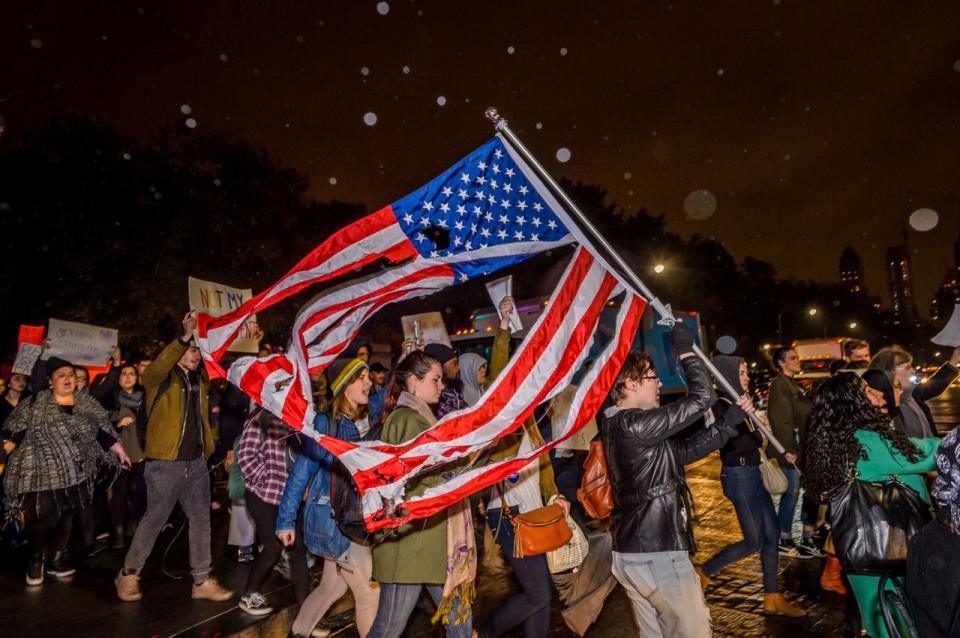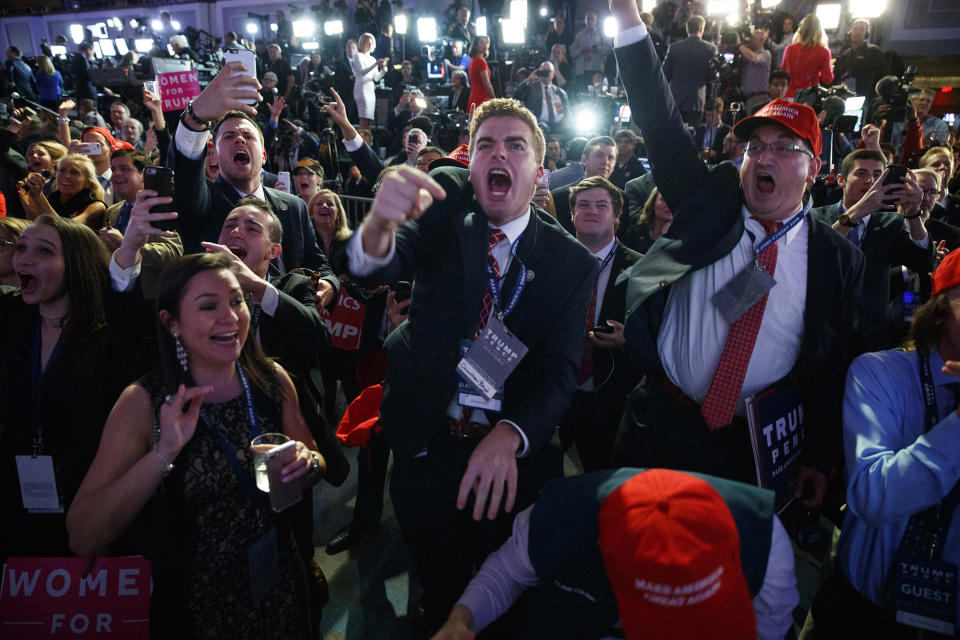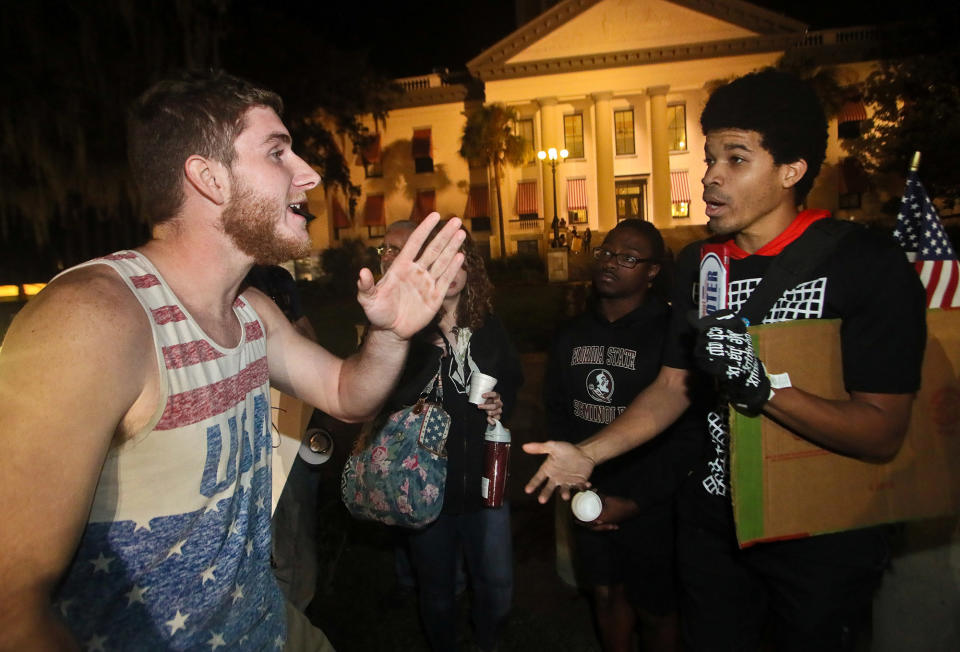Can a divided America come together under Trump? Historians weigh in

Donald Trump’s upset win after an acrimonious presidential campaign has thrown the fault lines of a bitterly divided nation into even sharper relief. A tide of animosity has fueled a spike in hate crimes, key states will see their election results subjected to a recount, and the incoming president has taken to Twitter to denounce the views of his opponents rather than unify the country and the still-smarting Democrats behind his leadership.
Against this backdrop I turned to historians and political scientists to ask how America is ever going to unwind the present atmosphere of dug-in political division. Do they see the country getting less divided at some point — and if so, how? Is there any way to reknit our divided America?
Sadly, the scholars agreed that the era of bitter partisanship in which we find ourselves is unlikely to abate anytime soon. The self-segregation of people according to lifestyle preferences, known as “the big sort,” won’t be solved by people moving from urban areas to less expensive exurban or rural areas, as some have advocated, because there are not enough jobs being created outside America’s cities to sustain such a movement of people. And any increase in movement the other way, from the exurban and rural areas to the cities, would only exacerbate the decline of the areas left behind. Meanwhile the rise of the new upper middle class — a prosperous urban fragment that’s grown as the middle and lower middle class have shrunk and lost ground — has obscured for many the struggles and difficulties of those outside the cities.
These sobering analyses are well worth pondering as Trump gets ready to take office. Responses have been edited for length and clarity.
Bill Bishop, author of “The Big Sort: Why the Clustering of Like-Minded Americans Is Tearing Us Apart”
It’s the politics of self-expression. That’s the era that we’re in. Just as “the sort” is a cultural phenomenon that only every four years is a political phenomenon. It doesn’t matter whether it’s Occupy or Black Lives Matter or Trump or the tea party — politics isn’t about policy, it’s about people expressing themselves.
The divisions in the political sorting are reinforcing every other division. If you look at life expectancy, income, education levels, regional accents — the differences place to place are increasing.
And the preliminary figures I saw in the political sorting were that the percentage of people who live in a landslide county, someplace where one political party won by 20 percentage points or more, was about 51 percent in 2012, and it’s over 60 percent in this election. And this election is closer. So yeah, those differences are increasing and they’re increasing across the board. I don’t see any turning back from that at all.

I mean, you hear from editors, “Yeah, geez, I see it — but I’m not living out there. I’m not living out where you live.” [Bishop lives in LaGrange, Texas—ed.] The outrageous behavior on the right is matched by a smugness on the left. And the only thing is, our friends on the left don’t even realize what they’re doing. I hear it all the time: “We’re educated. We’re open. We’re diverse.” Well, we’re diverse except for the people we talk to. We’re not diverse in our beliefs, we’re diverse in the kind of restaurants we go to.
But this kind of self-expressive politics has been matched around the world. That’s the product of modernity. Politics become individualized and primarily a mode for self-expression. So you see the same thing happening in France, in Great Britain, in all these places, where parties — on the left and the right — that are more expressive come to the fore.
People as they grow richer — and this comes straight out of research from Ron Inglehart at the University of Michigan — as people become richer they lose their respect for authority, and that’s what’s happened in this country since the mid-1960s. People no longer have the need to obey. The history was, as people’s survival became assured, which happens in the welfare state, they no longer have the need to belong to church or family or community, and as a result, respect for authority in all forms — science, business, labor unions, political groups — declines, and the values of self-expression and individual rights increase.
The structures that surrounded people’s lives — community, and what family meant, and church and tradition — all become less important. People become, to use the sociology phrase, disembedded from those institutions. And they’re on their own and become artists of their own lives and their primary occupation becomes describing themselves to themselves and to others. Thus Facebook. You become your own personal brand, and you have to constantly define and describe yourself to others. So the place where you live has to express your self, so that’s why you see this lifestyle sorting.
And then politics becomes more about finding the best expressive mode for describing one’s self. And Bernie or Trump or Marine Le Pen, or whoever it is who has a stronger expressive value, those politicians come to the front. It has nothing to do with policy.
It’s more about finding the politics that allows us to express ourselves more fully. That becomes the most important thing.
How do you turn back from the prosperity and the technology and globalization of modernity? You don’t. We look for individual solutions for everything, and in politics we look for the individual solution in the form of the unique personality, and that could be Bernie and that could be Trump. It’s certainly not Hillary or Jeb. The question is why do these right-wing expressive candidates seem to have more power, and I don’t know the answer to that.
Adam Goodheart, author of “1861: The Civil War Awakening” and director of Washington College’s C.V. Starr Center for the Study of the American Experience
If there’s a lesson the Civil War era has to teach us, actually it’s that when a big crisis comes, it’s a fallacy to think we can simply unwind things to where they were before.

The entire moderate middle in America at the beginning of the Civil War, and even throughout much of the war, thought that what they could do if the war ended was restore the country to a version of what it had been, to save the America that they had known and grown up with — and that just wasn’t possible. The country was going to be something new, and the question was: What new thing would that be? Who would hold the power and how broadly would that power be shared?
Every moment is different. It’s this common truism that history repeats itself. Well, actually, it doesn’t really repeat itself. It echoes itself. If there is anything that history teaches us, it’s that there always is something new, and we’ve never had a moment quite like this one before. We’ve never had anybody like Donald Trump step into the presidency before. I really don’t think there are any useful comparisons in American history I can think of.
The imperial presidency as we’ve known it is at most a little more than a century old. And we’ve certainly not had anyone come to the White House in that time who is as outspokenly dedicated to tearing down America’s civic and political and constitutional norms and traditions, and as unabashedly authoritarian, as Donald Trump.
So it’s safe to say that’s unprecedented. It may even really be unprecedented in any healthy modern democracy.
Groups split and recombine and split again through American history, and at some times in American history we’ve faced enormous splits, within, say, the white rural working class, and most dramatically the Civil War. Right now we seem to have a kind of a consolidation of the white rural, working and middle class throughout every region of the country. But we’ve seen huge realignments in the past, probably most recently in the 1960s, and so we know that we see realignments periodically, and that new coalitions will form and split apart again.
I suppose if there’s hope to be found, it’s that our democracy has so far managed to accommodate those transitions and only truly come off the rails once in 240 years.
Richard Florida, author of “The Rise of the Creative Class,” co-founder of City Lab and author of the forthcoming “The New Urban Crisis: How Out Cities Are Increasing Inequality, Deepening Segregation, and Failing the Middle Class — and What We Can Do About It”
What really shocks me is that this is the first time in my life it looks like the United States is really on the wrong side of history.
We avoided the other isms. We avoided authoritarianism. We avoided totalitarianism. We avoided fascism. And even though our crises were deep and our divides were deep, we were a society that was forward-looking, that was on history’s right side. I mean, we had the McCarthy era, we had all sorts of blips in our history — but Joseph McCarthy wasn’t our president. Now, it looks to me, America, for the first time in modern memory, has elected a president who is on the wrong side of history.
We ran correlations between Clinton and Trump voters: comparisons of Clinton to Obama, and Trump to Romney voters. The correlations were off the charts, they were 0.9. This is state vote share, so I’m comparing Clinton vote share to Obama, Trump voter share to Romney. The divide looks the same, more or less. It’s more acute, but it’s not like the tables have turned dramatically in terms of the divide in America. Those correlations are all similar.

And I think what happened is that in these locations — the stressed suburbs, exurban areas, rural areas — that’s where Trump tipped states from blue to red. So our divide is not that different from when we went into this election; it’s these tipping point communities in certain states that were blue for Obama and red for Trump. And also a lot of voters who were part of the Obama coalition stayed home.
I think this poses problems for America. Trump will be the candidate of not-the-cities. Mrs. Clinton won the cities. According to the Washington Post analysis, Trump won the suburbs, exurban areas and the rural areas.
Cities are engines — density powers innovation — the engines that drive our economy and create progress. This is a backlash against our very sources of progress, and that’s what worries me. How do we have a pro-urban agenda, how do we have the ability to address the challenges and abilities of our cities with a candidate who is the candidate from not-the-cities?
The “big sort” has become a bigger sort, a bigger sort on steroids. The driving force of that is not just cultural preference, it’s the fact that our economic centers of gravity are large cities and metropolitan areas. So if you want to pursue opportunity you move to where that opportunity is. It’s great to evoke “move to another place,” but the centers of opportunity in the United States and in the world are incredibly clustered and concentrated.
A third of the U.S. workforce are knowledge workers, professional workers, creative workers. That means 66 percent of the workforce is not. Blue-collar workers — the jobs aren’t there anymore. Jobs are being eliminated.
Our country is divided. It’s horribly divided. Donald Trump ran on hardening those divisions. It’s hard to see how Donald Trump can reknit our country. Don’t get me wrong, there will be some migrations out of these urban cores, these superstar cities and tech hubs, because they are expensive. We will see some migration because they are expensive. But it’s not going to change the balance of power.
We’ve got a civil war. It’s not a civil war in the military conflict sense, but we have a terribly divided country. It’s not just divided by our ideology — it’s divided by our class divisions and our locations. America has always been divided between rich and poor, now for much of our modern history we had a middle class, but one thing that’s happened is not only has the middle class shrunk, but middle-class neighborhoods have been eviscerated. So we no longer have those once sturdy middle neighborhoods and middle ground, which kind of knit our country together and created more opportunity for people.

Our country has divided into areas of concentrated affluence and concentrated disadvantage, and the areas of concentrated disadvantage are just housing more people. I don’t think it’s a privileged 1 percent, it’s a privileged third. About a third of our workforce and our population is doing OK. And two-thirds are falling further and further behind. And that’s the issue. And I don’t know how we reknit that.




